North British Railway
STATIONS - 17
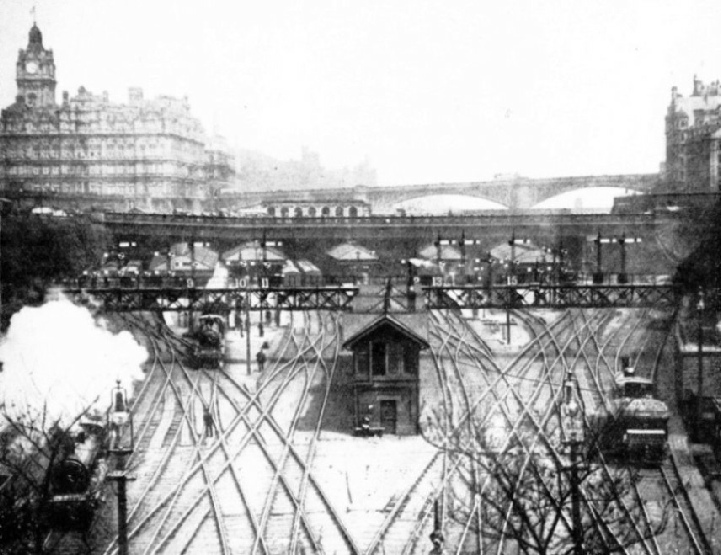
WAVERLEY STATION FROM PRINCES STREET GARDENS
IT is the aim of Railways to build their great stations in a city as near as possible to a main thoroughfare. At such points of vantage they can both “tap” the passenger traffic and suit the convenience of the public. The North British Railway has been most fortunate in this respect, for Waverley Station stands at the east end of the world-famed Princes Street and at the junctions or termini of all the great traffic routes of the city of Edinburgh.
In some towns one is made aware of the proximity of a great railway station from the well-known evidences of it which are within easy sight and hearing from the thoroughfares. In many cities, however, both in this country and on the Continent, one finds handsome station buildings of elaborate architecture, and their frontages and propylea might rank honourably with Municipal Buildings or City Halls. The great landmark of Waverley Station is the magnificent North British Hotel, beneath and around which imposing structure extends the station, covering many acres of ground. From Princes Street there can only be seen a great expanse of glass roofs, which are slightly below the level of the street, as the station itself stands low. But as the west and north lines traverse for more than half a mile the fine Gardens which bound Princes Street on one side, the smoke of trains, and at some points the trains themselves, can be seen from the street. The principal entrance to the station for pedestrian traffic is by steps leading down by the side of the Hotel, and for vehicular traffic by the Waverley Bridge, from which separate carriage ways are provided for ingress and egress.
The trains, platforms, docks, offices and general equipment of the station are all protected by glass and iron roofs of considerable height. Nowadays, airy, well-lit, expansive structures have replaced most of the dingy, smoke - laden and cramped railway stations of earlier times. Wide and long platforms, roomy entrance halls, and convenient and systematic arrangement of “docks” have now a place in all modern station designs, and these are a feature of Waverley Station. When one enters its precincts, the mind, perhaps unconsciously, becomes impressed by the sense of immensity and importance and of the zest of life in the place. True, one becomes hardened to such influences. The business man hurrying to catch a train; the woman with children and luggage to look after; nay, all who must rush to stations and trains, laden ever with the toils of life, have little heart to share in such thoughts and feelings. Yet, in their times of less strain, let them think of the fascination which may invest a great railway station. Let them enter it now with leisured step and awakened interest, and minds alert upon the greatness of common things. It is mainly the human interest to be found in and about a railway station which is the secret of its fascination. Who hath eyes to see, will see. Retire then, Spirit of the Age, to whom the clank of metal and the roll of wheels is everything, and let the deeper, gentler thoughts of Romance have play.
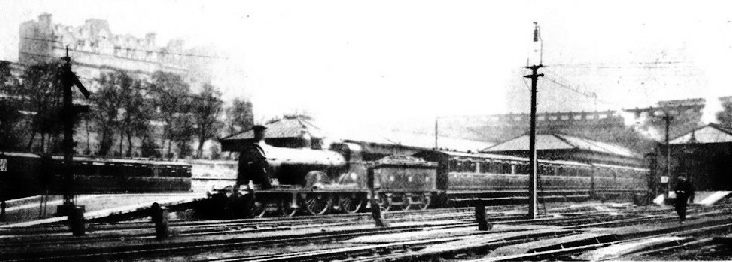
PERTH AND INVERNESS EXPRESS ABOUT TO LEAVE No. 10 PLATFORM
The pulse, then, beats quicker as we enter a great railway station like the Waverley. The entrances are animated, and the attention of the public is divided between the medley of cabs and vans or the hurrying crowds of people, on the one hand, and the profusion of notice or direction boards or tourist advertisements lining the entrances on the other hand. The travellers are tempted, perhaps, to forget their own humble destination when confronted by the gaudily illuminated advertisements enticing them to distant and attractive health or holiday resorts. Alongside of the board directing passengers to local or suburban trains, they may find others intimating the starting platforms for excursion trains for various parts of England, the dining-car trains for London, etc. Here are mystifying timetables and train bills, notices of holiday fares, and the like; there are pictures of Swiss mountains, or Norwegian fjords, of Killarney lakes, or the coasts of Normandy. But they are soon carried past these allurements by the stream of people, and find themselves on the level of the platforms. Impatient travellers besiege the entrances to the booking offices and carry through their ticket transactions quickly with invisible agents within. For all the world, this reminds one of bees at a beehive, whose interior is shut off from view, but whose tiny doorway is the scene of ceaseless and vigorous traffic. The Central Booking Hall of Waverley Station is a fine building, with high dome and mosaic tiled flooring, and is a model for orderly arrangement.
When travellers have secured their tickets they may be in doubt whither to turn to look for their trains. On busy days, outside the Booking Hall, the North British Railway Company often provides officials whose sole duty it is to shout the direction and platform for certain trains. The passengers hear, and look, and pass on - usually with no thought of gratitude or interest towards these officials. Their day’s work is merely that of animated signposts, but let them be remembered here with kindly remembrance. In a way, they are much more the servants of Destiny than of Railway Companies. If they can direct us right and timeously, a train may be caught! Thus, a precious life in danger somewhere may be saved; we may be yet in time to receive the parting messages of someone setting out on his last lonely journey; a business appointment on which hangs credit or wealth may be kept; a day of happiness with distant friends may be ours; or an impending calamity at home may be unconsciously escaped! Shout well, then, humble servants of the “road”, with now a tone of warning, now of entreaty in your voices, and make sure we understand you when Destiny whispers in your ears that it will be well for us and ours that we hear you and obey.
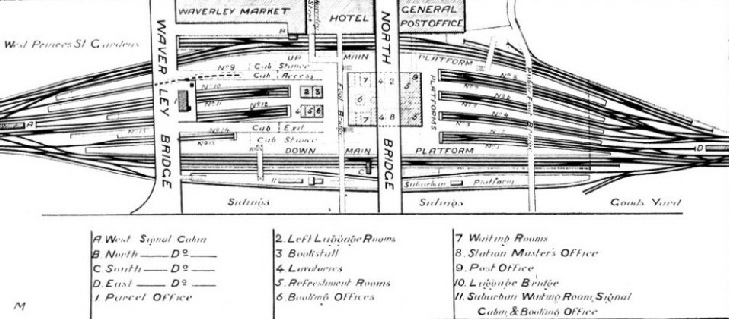
PLAN OF WAVERLEY STATION, EDINBURGH
On the platforms themselves all is movement, and there is much noise. Smoke there is, too, and a curious odour - a not unpleasant amalgam of steam, oil, and smoke. Trains are arriving here; and departing there. Some, now empty, are being shunted out of the train docks, and others with their complement of passengers are getting ready to start. We hear the hissing sound of escaping steam, the whistling of various engines, the throbbing of Westinghouse brakes, the rolling of carriage wheels, the banging of doors, the rumble and rattle of luggage barrows, the cries of the boys from the news and fruit stalls, and the shouting and whistles of the officials - while mingled with all these sounds is the babel of the many voices of passengers and their friends and others. To nervous or excitable people all this is undoubtedly torture, and it is well for them if they can set out for travel at hours and from stations at which they may not be driven to distraction by such clamour and bustle. But for the majority of people, the more robust, such things have much attraction, because there we are in the swim of life. Swift movement always captivates. Not only are we in the midst of hurried activity of people at a railway station, but we know that there we are at the place from and to which journey those embodiments of swift motion - railway trains.
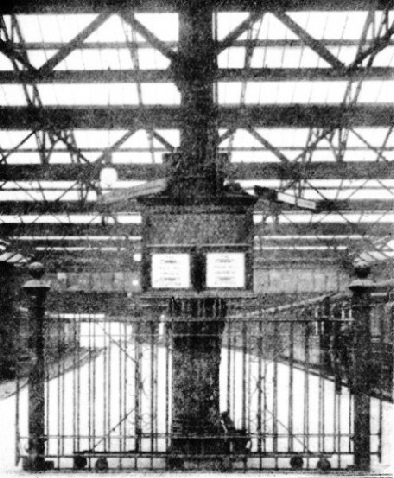 Waverley Station is no exception to the rule as regards bustle and noise, but, above and controlling all, there is - method. It is a through station of first importance as well as a terminus. From the south, there converge into it the two great trunk lines from London of the East Coast and the Waverley and Midland respectively.
Waverley Station is no exception to the rule as regards bustle and noise, but, above and controlling all, there is - method. It is a through station of first importance as well as a terminus. From the south, there converge into it the two great trunk lines from London of the East Coast and the Waverley and Midland respectively.
TRAIN INDICATOR AT ENTRANCE TO Nos. 11 AND 12 PLATFORMS
On arrival at Waverley, portions of many of the trains of these railways are detached and form part of North British trains going westward to Glasgow, or northward to Perth and Aberdeen. Or vice versa, passengers who have travelled from Aberdeen (including stations beyond on the Great North of Scotland Railway), from Wick and Inverness (and other stations on the Highland Railway) and Perth; and from Glasgow (including Mallaig or Fort William at the western limits of the West Highland Railway) all meet at Waverley Station and proceed to London by either the East Coast or the Waverley and Midland route. The north side of the station is reserved for the “main up” (to London) lines, while on the south side are the “main down” (from London) lines. The whole station is situated practically within the sweep (in diamond shape) of these two trunk lines. Numerous “docks” are formed at both east and west ends of the station, and from these “docks” are worked the more provincial or local traffic of the North British Railway. The only lines which lie outside the main portion are the City Suburban lines, which are conducted through a miniature station (again of diamond shape) situated to the south of the main portion. From the “docks” at the east end of the main station trains are worked between Waverley and places such as Granton, Leith, Musselburgh, North Berwick, Dalkeith, Peebles, Selkirk, etc.; while from the “docks” at the west end trains are worked between Waverley and Glasgow and the West, Perth, Dundee, Aberdeen, Stirling, etc. Exclusive of the “main up” and “main down” platforms, there are fifteen platforms in the main station. But as may be inferred from what has been said above, the whole arrangement of them is so natural and methodical that there is no confusion. Each platform is numbered, and large notice boards at either end of the central station buildings readily show intending travellers where to find the trains they want. If they have doubts (as all travellers seem to have at a railway station!) these may be removed by listening to the directions offered by the men already referred to, who are usually stationed at busy points in the station. When people come to the station to meet the arrival of trains, they may consult the “Train Indicators”, of which two (for north and west trains) are placed conspicuously in the west part of the station, and two more (for south and east trains) in the east part of the station. These indicators are controlled from the signal-cabins, and a few minutes before trains are due to arrive they show by means of revolving discs the platform at which each train will come in.
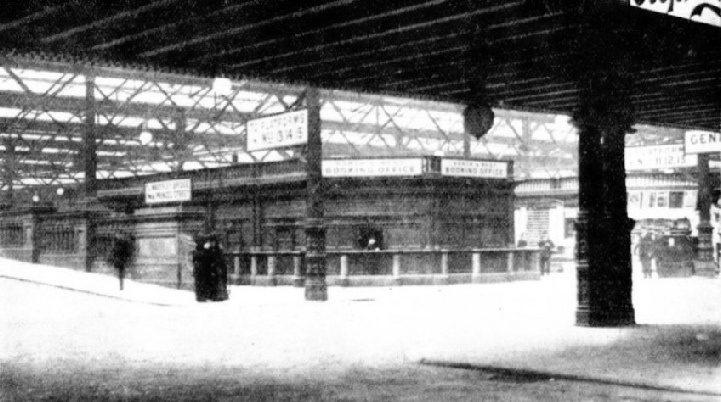
THE MAIN ENTRANCE TO WAVERLEY STATION AT PLATFORM LEVEL, SHOWING BOOKING OFFICE
FOR NORTH AND WEST
It is estimated that about 720 passenger trains in all arrive at arid depart from Waverley Station in the course of a day, but the total number of all classes of trains amounts to over 1,300. On June 6th, 1908, an account was taken of the total number of trains and engines in and out of Waverley, and these numbered 1,319 (being 731 at the east end of the station and 588 at the west end). It may also be stated here that the total area of the station is 23 acres (including 5 acres appropriated by the Waverley Goods Station), 11½ acres of which are under cover. The total number of platforms is 19, and their aggregate length is 13,980 feet. The number of carriages which can stand alongside the platforms at any one time is approximately 358.
A railway station speaks of epochs of decision in life, a parting of the ways, cross-roads in conduct. Shall we embark upon this adventure; shall we definitely declare our hand; shall we make a break in habit; or a departure from principle? Are we fleeing from Nineveh and duty, or going where Love and Right beckon us? As we wait at the station are we still counting the cost, and weighing consequences in the balance? Are we making a sacrifice in going away? Have we left a clean record behind? When the train has borne us away and we settle into our corner, have we feelings of remorse or satisfaction? Where will the journey’s end be? Ah! where, indeed? But have we done the right thing now according to all the lights of reason and grace? - then we may in faith leave the end in better Hands.
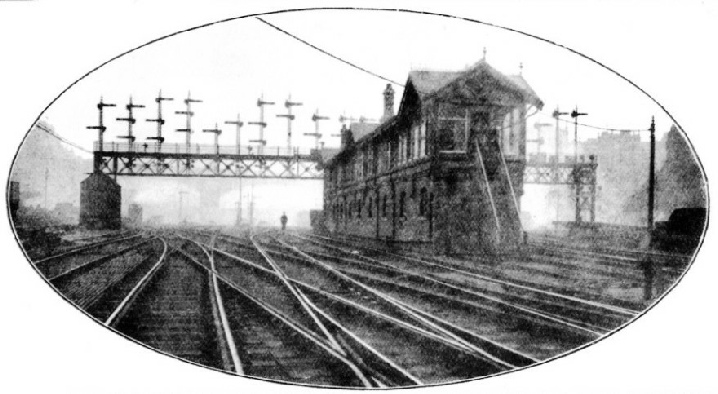
SIGNAL BOX AND SIGNALS AT EAST END OF WAVERLEY STATION (LOOKING WEST)
It is now only 9.20 p.m., but the London express which is due to leave at 9.50 is already “made up”, and is standing in its accustomed place at the “main up” platform at Waverley Station. The engines which are to haul it have not yet come from “the sheds”, and without them the train looks somehow headless and unimposing. Some anxious travellers have come down to the station early, and are already securing places in the train. The ticket-collectors are marking up with labels those compartments or seats which have been previously reserved by intending passengers. The parcel vans on the train are being filled from heavily-laden barrows, and the official in charge assists and superintends the placing of the multifarious articles in the corners of the vans respectively allotted to various towns or districts. Travelling trunks, bags, bales, packages, chests, boxes, baskets, barrels, paper parcels, bundles of nursery plants, fish creels, and many others comprise the assortment in the “parcel” vans so-called. Those parcels destined for the same town or junction must be placed together and in positions where they can be most readily taken out, and “way-bills” for each must be delivered to the guard or other official under whose charge the vans are. While this is proceeding, we have time to stroll to the end of the platform in front of the train, and there is always plenty to see there. Near us stand the short “home” or starting signals, the large notice boards indicating the names or numbers of the platforms, and also huge water-columns, each with its leathern conduit which looks like the disused trunk of some leviathan elephant. The line of rails on which the carriages of the 9.50 train stand pass out at our feet to mingle with and seemingly to be lost in the labyrinth of rails beyond - “diamonds”, “forks”, guardrails, lock-bars, and points - amongst which the eye wanders hopelessly confused. Stretching across the whole network of rails is a high bridge on which most of the signals pertaining to the east end of the station are erected, and the great signal cabin stands on the further side. From where we stand we get an easy view of all the outgoing and incoming trains, and we are so intent on watching them, that we have not noticed the two enormous engines for the 9.50 coupled together gliding slowly backwards to take their rightful place at the head of the train. As they approach, we try to take in a true sense of their power and weight and the intricacy of their works. We note the number of their driving-wheels, the length of their driving-rods, their inside or outside cylinders, the height of their boilers, the shortness of their funnels, and numberless other details which it is a constant delight for those who are interested in locomotives to observe. We watch the engines being coupled up tightly to the first carriage and the brake pipes and steam heating tubes connected. Then the brakes of the train are tested from the engines, and when the steam is admitted into the heating tubes, it is soon seen to ooze out at joints below and between the carriages. One of the guards of the train now comes to make the acquaintance of the drivers and firemen of the engines, or, to be more accurate, to get information to be recorded in his journal as to the numbers of the engines, and the names of the drivers. He also informs the drivers of the number of vehicles (or “wheels”) making up the train “load”. This done, and any other tit-bits of information having been exchanged, - for example, orders to stop at certain places to set down or pick up passengers, - there is a momentary interval of friendly conversation or “chaff”, without which indeed any occupation would become unbearably dull. There is usually time for it, and it “lubricates” the performance of daily tasks, as does oil the axles.
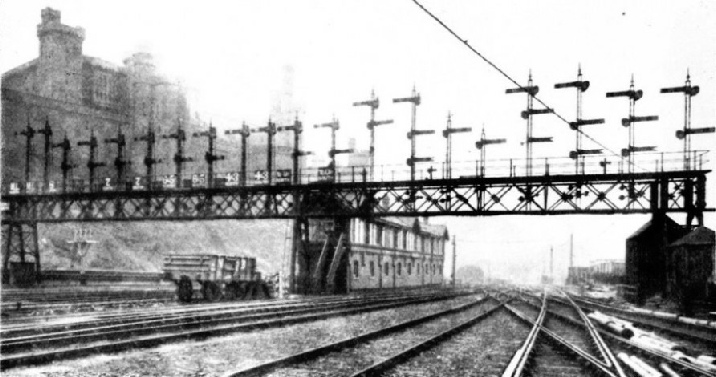
SIGNAL GANTRY AT EAST END OF STATION (LOOKING EAST)
There is now a little group of interested people on the platform opposite the engines, and on scanning their faces, one finds that they represent many grades and kinds of people. A curious group, indeed! - some mechanics, some idlers, some youths, some dreamers, but all of them admirers of the iron horse. Steam being up, the boilers full, the furnaces replenished, all is in readiness; and the enginemen now stand on the edge of the footplates, looking back along the train, to be in readiness to receive the starting signal. They know their business, these men, and we may trust them to do it well. The platform is crowded with passengers and friends and station officials, and everyone is busy. Most of the passengers have secured seats, but there are numerous latecomers who agitate for places in the train. Barrowfuls of luggage are being quickly disposed of in the vans, tickets are being checked, and all the final preparations made for the departure of the train. Porters, ticket collectors, car attendants, guards, and stationmaster all play their respective parts in willing co-operation.
And what of the passengers and their friends? Who may fathom, much less portray, the thoughts and emotions surging within their minds and hearts? The grief and pains of separation, the hopes, the fears, the loving care, the prayers, the joys, the trust! - how ill-concealed by some in affected gaiety of mood; how patent in others who do not attempt to conceal! Here are soldiers or sailors, with troops of acquaintances to see them off. There are some boys or girls going away to school, their fathers and mothers filling up the moments of waiting with many injunctions in order to shut out anxieties which their children must not see. At another place, a wife is bidding good-bye to a husband whom duty calls hence. Elsewhere, an only son and brother is setting out into the great world to win a name and place. In the corner of another carriage there sits, his face screened by a magazine, some lonely soul who has no one to bid him adieu at this end of his journey or welcome at the other. At another compartment, a happy wedding party is assembled, and amid merriment and showers of confetti the “happy pair” are getting a good send-off.
These and a hundred other scenes one may witness at the departure of an important train such as this. There may be tears, or mirth, or calm demeanour, but, in all, the life of feeling runs high. It is betrayed in the firm grasp of friends’ hands, eye meeting eye in unspoken eloquence, or in partings between hearts that know the anguish of love. Adieu ! Adieu! The train has begun to move; but one more touch of the hand, and a last long look, and a waving of the handkerchief till the train has passed out of sight. Ah I it is all so real, and so near the uncurtained deeps of the heart! These people have not been playing a part, and we, who have been looking on, must turn quickly on the heel, lest we, too, may show more feeling than is due from interested spectators. There are many such to be found amongst the crowds that always haunt the Waverley Station at Edinburgh. Such are under the spell of the fascination and romance of a great railway station.
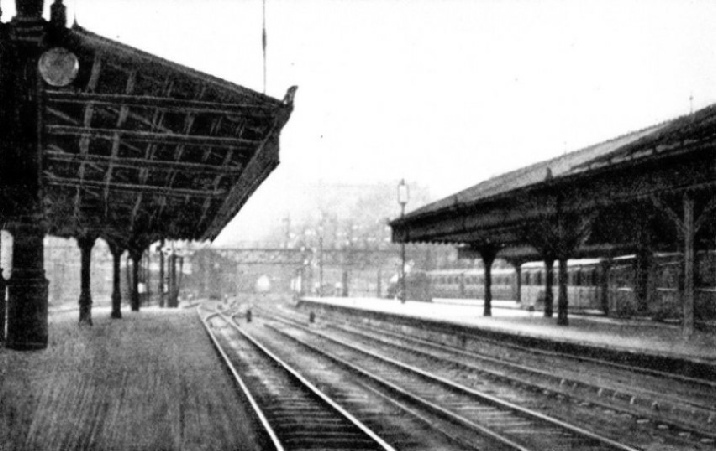
WEST END OF WAVERLEY STATION WITH MOUND TUNNEL IN THE BACKGROUND
You can read more on “The Flying Scotsman”, “The North British Railway”, “The Railways of Caledonia” and “The Romance of the LNER” on this website.






 Waverley Station is no exception to the rule as regards bustle and noise, but, above and controlling all, there is -
Waverley Station is no exception to the rule as regards bustle and noise, but, above and controlling all, there is -


